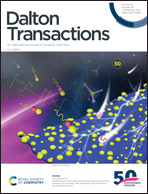Bi3+ photoluminescence in Y1−xBixCa3(GaO)3(BO3)4 and energy transfer to Eu3+ and Tb3+ in co-doped phosphors†
Abstract
Bi3+ possesses outer shell lone pair electrons, and, thus the so-involved photoluminescence (PL) is sensitive to the surrounding coordination. Besides, the similarity in the structural chemistry between Bi3+ and rare earth (RE) ions inspires us to investigate the Bi3+-PL performance in RE3+-containing hosts. Herein, Y1−xBixCa3(GaO)3(BO3)4 (0.01 ≤ x ≤ 0.15) compounds were prepared by a high temperature solid state reaction method. The successful cationic doping and phase purity were confirmed by powder X-ray diffraction analysis. This series of phosphors exhibit the very strong absorption of Bi3+ 1S0 → 3P1 at 272 nm along with the intense blue emission with a maximum at 399 nm and a full width at half maximum (FWHM) of 59 nm. They retained 78.86% of the emission intensity at 150 °C, with reference to that at room temperature. Moreover, Bi3+ could also behave as a sensitizer to enhance the emission efficiency of RE3+ and thus to realize color-tunable phosphors. The energy transfer was proved in the co-doped phosphors Y0.95−yBi0.05EuyCa3(GaO)3(BO3)4 (0.05 ≤ y ≤ 0.6) and Y0.95−zBi0.05TbzCa3(GaO)3(BO3)4 (0.05 ≤ z ≤ 0.6), and color-tunable emissions from blue to red, or from blue to green were realized in these two series of phosphors.



 Please wait while we load your content...
Please wait while we load your content...